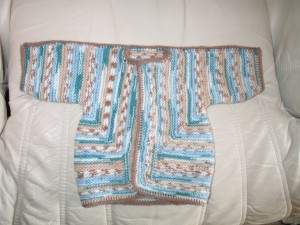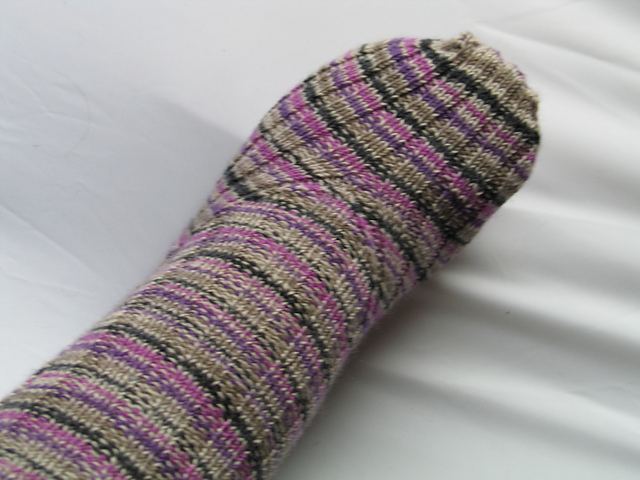8years ago I sat at my mum’s bedside hoping and praying that I could share just a few more days with her.
She took her last breath before I saw her again.
I wish I had been with her, to hold her hand, to comfort us both.
I wish she could have met the baby girl that was growing inside me, I know she would have been incredibly proud of my beautiful girl now almost 8yrs old and proud of me for that.
There have been many times between now and then when I would have done anything for a few wise words from my mum.
I hope am as a good a mum as she was and that my daughter gets longer with her mum than I did with mine.
That is all.
Knitting
Equality Stripe Cardigan and Hat
New pattern release Equality Stripe Cardigan
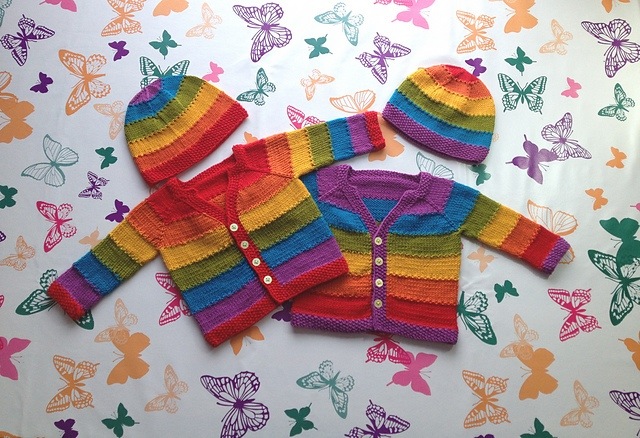
Equality Stripe Cardigan is knit top down from neck to cuff in one piece including button bands without seaming or picking up stitches for a button band!
Full photo tutorial for switching colours for the button band is included.
Sizes: Newborn, 3-6m, 6-12m, 12-18m, 18m-24m, 2-4yrs, 4-6yrs, 6-8yrs.
Yarn: Heavy fingering (4ply) or sport (5ply) weight yarn. Samples knitted in 6 colours of Katia Merino Baby.
£3.00 
Matching Equality Stripe Hat
Sizes: Newborn, baby, toddler, child, adult and large adult.
£1.50 
Or both patterns together as an ebook for £4.00 
I am now part of the LYS In-Store Sales program. So participating yarn shops can sell my patterns directly to their customers in store. All the patterns that I have available for purchase through Ravelry are in the program.
These cute little unisex cardigans were inspired by a close friend of mine who was pregnant with non identical twins. She asked for ‘rainbow coloured knits’ rather than the traditional white or pastel baby colours often gifted to those who don’t know the gender of their baby before it arrives.
So I ordered some lovely soft yarn (Katia Merino Baby) in 6 rainbow colours and grey. The idea of the pattern took hold in my mind before the yarn even arrived.
After the first was off the needles it seemed only logical to make the cardigans ‘fraternal’ for these *fraternal twins. So I reversed the rainbow colour ordered and the second cardigan was soon complete.
*fraternal twins; meaning twin developed from two separately fertilized ova; dizygotic. (Developed from two eggs, each fertilized by separate sperm.)
With plenty of yarn to spare, these special babies deserved matching fraternal hats too!
So out of 6x 50g ball of yarn came 2 cardigans and 2 hats with significant yarn left over.
I released the hat pattern during the 2014 Sochi Olympics, to show support for LGBT difficulties in Russia. Donations were made to Stonewall during the Olympics in lieu of pattern fees.

Now they are both patterns available to buy trough Ravelry or you can use the links above.
Of course you don’t have to knit them in rainbow colours, 6 random colours or just 2 or 3 colours will be just as fun.
The joy of releasing a pattern hasn’t got old for me yet and in between pattern releases I forget just how great it feels. So this time, like all the times before it, I was surprised by the smile on my face and the joy of knitters seeing and liking my work.
Seeing my pattern rise up through the Ravelry hot right now list is always a little thrill. Often one I am too busy to spot, but someone points out to me.
While you all enjoy this I am working on getting my next design tech edited and test knitted.
Happy knitting!
Teyla Shawl
The unusual construction forms a semi circular shawl which hangs comfortably over your shoulders, with a textured stitch pattern and 5lace panels. Knitted from the nape of the neck outwards in one piece with easy resizing options included. Charted instructions.

Requires 4ply/fingering weight yarn – 625metres for the Shawlette size or 1000m for the Shawl size. It will look lovely in any weight yarn.
Teyla Shawl is the second shawl pattern I have self published.
It’s construction was a little different from the hundreds of triangular shawls and I think the textured stitch makes a lovely change from stocking stitch for the body.
The design came from paging through Barbara Walker Treasury’s, then modifying 2 lace patterns to meet my needs for the shawl. I wanted something that only had lace on the right side rows, with the wrong side rows being just purl.
Teyla Shawl came to fruit quickly and with the help of some lovely pattern testers and a tech editor it is now available for Ravelry Download.
Spinning for Fair Isle & A Poorly Cat
I’ve been quietly concerned about my old cat for a while now. Cuddles has just turned 19years old, which is a fantastic age. We’ve been lucky with him day one, with exception of being hit by a car when he was a kitten, he’s never had much need for a vet.
Sadly for the last 2years he’s had random bouts of diarrhoea and loosing weight, then he goes off his food. Each time the vet can find nothing wrong and further tests would require an anaesthetic, but he’s always got better and gained the weight back when his appetite returns. After several episodes like this the vet assumed it was some form of irritable bowel disease.
We had learnt to live with this occasional problem and it didn’t seem to be getting worse.
But over the last 6months he’s got more doddery on his back legs, unable to jump as well, and unable to sit down properly. He’s old and didn’t seem to be in pain with it (though it’s often hard to tell with cats) so we assumed it was old age causing stiffness and maybe arthritis. But in the last 2months those diarrhoea accidents have turned into solid poop accidents. Which from a super clean cat who washes obsessively was very odd. I noticed he was a bit smelly, and put it down to the pooping and washing less. He shows many signs of dementia so we gave him plenty of leeway and again didn’t worry as he seemed happy.
In the last 2 weeks I noticed slightly wet patches in his bed and on the floor (thankfully he’s been shut out of carpeted rooms for a while), saw him do solid poos while walking about and seeming totally surprised. Then when sleeping on my lap he wet himself (or should I say he wet me!!) I knew something was really wrong and off to the vets we went.
The vet didn’t seem sure and ran some full blood tests, wondering about thyroid, kidney disease, urinary infection (and dementia while doesn’t show in blood tests!).
So the last 2days I’ve nervously waited for the results, wondering if his time had come to an end.
I stayed up very late spinning both evenings plying some BFL/silk in yellows and oranges and spinning and plying some Romney fleece I’d dyed purple.

The plan for these contrasting mini skeins is a fair isle bag from the latest spin off magazine.
More cat news to follow as the results come in.
Stripes
After 2 courses of antibiotics and a week in bed in agony. Did I mention just how bad this toothache was? We are now wondering if it is also neuralgia, this would explain why it’s been so much worse than regular toothache. Yesterday the antibiotics finally started to feel like they are working and the episodes of severe pain stopped. So I recommenced some knitting, which saved my sanity I’m sure. I think I was right on the edge of break down, not being able to knit makes life so hard!
I stayed up late working on my stripes, having slept during the day when I was released from the pain. Going to bed didn’t seem like a priority now I could knit again. I worked 4inches of one front for my cardigan before forcing myself to go to bed and listen to ‘The Hunger Games’ as I fell asleep. I am really enjoying it so far and it’s well read, I’m hoping it’ll be a good use of 3 Audible credits.
I’m really pleased with the 1 row button holes, they are the method Ysolda describes in ‘Little Red In The City’, they have a good firm edge and don’t feel like they will stretch out over time.
I’ll post more about the simple clean looking Cardigan when I’ve started the back and can post some photos of that.
I didn’t want to speak too soon, but 2 weeks ago a friend welcomed the first ever lambs into her Polworth flock. The ewe had been very sick and we were all very worried about her, even the vet. She eventually squeezed out 3 beautiful pure Polworth lambs. Unfortunately 1 lamb didn’t make it, but the 2 ewe lambs are being bottle fed and getting stronger every day. I was asked to help out with the lambs when my friend has other pressing things to deal with, so I had the pleasure of bottle feeding 2 beautifully 3day old lambs. Polworth’s have wonderfully fine fleece, the breed was originally established by crossing Merino’s with 1/4 Lincoln. This gives them the fineness of Merino with some of the length and lustre of Lincoln. The addition of the Lincoln also makes them slightly more suited to the English climate than purebred Merino sheep.
I’ll dig out a photo of some yarn I spun from English Polworth fleece last year for my next post.
Finish-itus & Unravel
Finishitus* like Startitus* is highly contagious I’m sure, so I feel it’s only fair I warn you that I seem to have caught this wonderful bug. I’ve longed for a case of finishitus for years, as I have recurrent startitus.
So I finished my Mitred Socks (which I cast on in 2010!) 
and finished the first of my Toe Up River Socks 
I also finished a pair of leg warmers, but having been a wip for over a year, my gauge had changed so the second is too small. So They are now back on the needles.
Feeling very motivated to finish some projects and I’m managing to resist the urge to cast on new things. I desperately want to finish these socks –Arch Shaped Socks
I literally have 10rounds to go on the second sock, but I can’t find it, which is super frustrating!
I went to Unravel and Farnham Maltings last weekend, it’s a great fibre festival but a little cramped. It was pretty busy and that means tiring for me, but well worth it. I had promised myself no fibre, fleece or yarn, so I happily walked past all that. Until WidowTwanky started looking at sock yarns, then I was doomed! So I came home with a ball of Lang Sock yarn and 2 balls of another sock yarn (I can’t remember the name right now).
This also led the purchase of a ball of solid purple Regia sock yarn from my local yarn shop to use with the variegated yarn I bought.
After a recent #bargainbals splurge (Regia 6-fadig College – 150gram balls of sport weight SW wool/nylon Sock yarn, £3.99 from Kempswoolshop) I really can’t go buying any more yarn for a long time.
I also bought some more Knitpro tips and KnitPro padded crochet hooks from Knitting4Fun, they had the cheapest priced KnitPro’s from the vendors at the show.
I also got 2 new books ‘200 Fair Isle Motifs’ and ‘Blocks, Blankets and Throws’. The first I’ve been meaning to buy for a while and the second is much better than the cover would lead you to believe, it contains lots of techniques and ideas on joining panels/blocks in both knitting and crochet.
Hopefully I will manage to finish a few more projects in the next week or 2, before my finishitus fades.
*Finishitus – a compulsion to finish all works in progress. It is thought to be contagious, but very rare.
*Startitus – the much more common and high infection compulsion to cast on new projects, despite having many projects already.
Change of pace
Since the autumn started the onset of cold weather has left me struggling to manage my ongoing pain. Which has meant a lot less spinning and almost no dyeing.
It has given me a chance to do some Christmas gift knitting and finish a few WIP’s. Here’s a small selection;
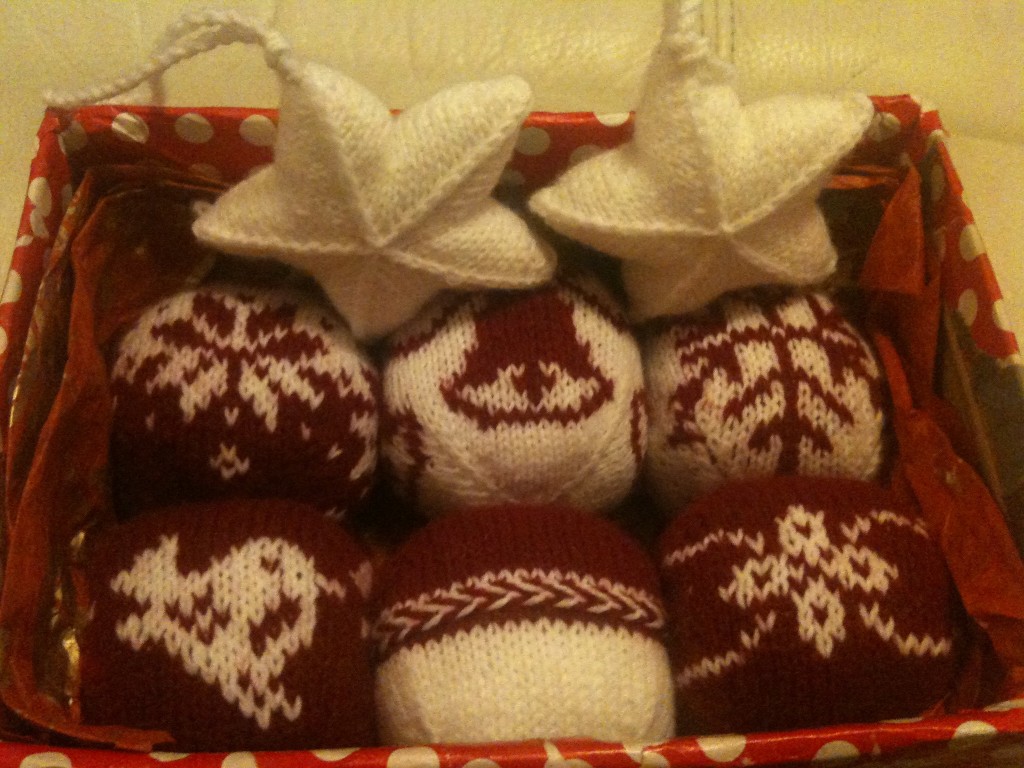
Knitted Christmas Baubles (from “55 Christmas Balls to knit” and hanging stars based on a free Ravelry pattern)

Double knitting (2colour, 2sided) Coasters in 4ply wool (based on a free Ravelry pattern for pot holders)

Cute red hat with reversible ear flaps using the Owls chart, this is to match a Cardigan for Emily. Still needs beads for eyes.

Simple yet effective lavender favours to keep draws smelly nice.

Another cute hat, this time with stranded colourwork bunnies and a bunny tail style pompon and earflaps.
Odd Shaped Shawl Calculator
Here’s a little way to calculate the maximum number of rows you can work on a shawl (top down shawls only). You need to have knitted at least 20% of your yarn to do get an accurate answer, it will give you a result as long as you have used more than 10% though.
Odd Shaped shawl
This calculation will work for any shawl pattern that starts at the top and has a consistent rate of increases along the length. (ie. 8increases in 9 rows out of 30 = ( ( 8 * 9) /30 ) = 2.4sts per row)
(ie Teyla Shawl)
The yarn usage and stitches per row won’t be as exact for some patterns, Teyla for example increases every row for several rows, then not at all for several more. So the Stitches per Row and Maximum number of rows will only be truly accurate if they fall on a pattern repeat.
I could alter the script so that you enter the pattern repeat length and it only gives answers for full repeats, but it probably isn’t worth the effort. (Please comment if you think that would be more helpful.)
(Use my triangular shawl calculator for regular triangular shawls like Ishbel, Aeolian, Laminaria, Traveling woman, Gail, Dew Drops, Danish Ripple, etc)
You need to know:
This Calculator requires javascript to be enabled.
I hope you find this page useful, I provide it free for everyone, please link to it here.
Contact me through Raverly, or email me if you have any questions.
P.s. Don’t blame me if the answer doesn’t work out for you, I provide this script working to the best of my knowledge, free to everyone.
(c) Bex Hopkins 2010, please do not attempt to steal this script.
If you would like to know how this is calculated please contact me.
Spinning for a project – Use of colour
I am quite keen on making the most of both the time I spend spinning and the fibre I use, to that end I spin most of my yarns with a project in mind.
Hand dyed spinning fibre is a big temptation, but so many spinners are disappointed with how their yarns knit up. Due to; muddied colours, barber pole effects, length of colour repeats, strong striping, dye lot changes, etc. The list is endless.
So I thought I would write some blog posts addressing these issues.
The first issue I thought I would address is the effect on the length of colour stripes when the width of the knitting fabric changes.
Eg. You spin some beautiful yarn from hand dyed top or graduated batts, and proceed to knit a triangular shawl which starts with a few stitches per row and increases to several hundred per row.
The closer you get to the edge the thinner the bands of colour become, to the extent that the edge doesn’t even have stripes.
The effect may be pleasing, or it might not.
To keep the bands of colour more equal make a simple change to the way you prepare your fibre before you start spinning.
Here is an example:
I have 100grams of hand painted top which has repeats of colour along its length and 100grams of hand dyed top which has very little variation in colour.
I plan to spin both lots of fibre and ply them together to form a 2ply.
I then want to use it to knit a large circular shawl, If I work from the top as I received it, without any splitting the resulting shawl with have a large circular of colour in the middle with the bands of colour getting smaller and smaller towards the edge and even mottled at the far edge.
If I want the bands of colour to have a similar width across the diameter of shawl I can strategicly divide the fibre before I start spinning.
For this example I will just divide the fibre for 1 ply and leave the second more solid fibre as is.
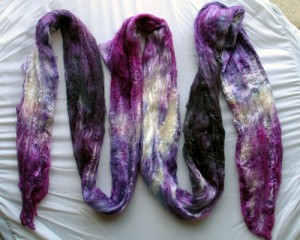
I split the fibre in half length ways as my fibre is a silk brick which is much wider than regular top, so for regular top skip this step or your fibre may be too thin to split further.
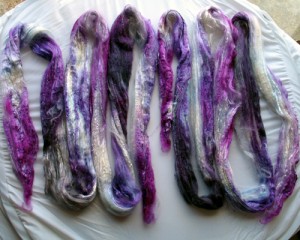

Next comes the strategic dividing of fibre. I broke the top into 5 fairly equal pieces, you can do this based on the colour repeats in your fibre for best results.
The first piece is not split at all (1). The next piece is split in half lengthways to make 2 thinner strips (1/2). The next piece is split into 3 lengthwise for even thinner strips (1/3). The next piece is split into 4 lengthwise (1/4). The last piece is split into 6 lengthwise (1/6) (I can’t manage to get 5 equal strips so I do 6, I do this by spliting in half, then spliting each into 3.) You can see in the photo the piles of fibre getting thinner from left to right.
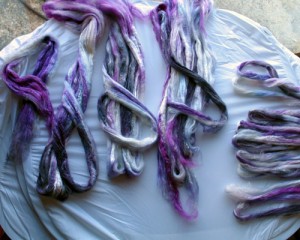

I then crochet chain the strips of top in order so that they don’t get mixed up before spinning, if you want the colours to follow in sequence make sure you take note of the ‘start end’ and the ‘end end’.
You can see in this picture that the chain goes from fat, to thin and then thinner, the thinnest I rolled into a ball as it would be messy to chain.

When you have spun and plied your yarn you want to use the end with the short colour changes at the small part of your shawl (centre for round shawls) and the slow colour change end will be for the longer edge of your shawl.
For this fibre I will straight 2 ply with the 2nd solid ply, but you could navajo ply for great colour alignment. Or if you are really confident in your dividing skills divide in the same way for both plies for a matched 2ply.
I’ll update this post with a photo of the shawl when its finished.
Triangular Shawl Calculator
Here’s a little way to calculate the maximum number of rows you can work on a shawl (top down shawls only). You need to have knitted at least 20% of your yarn to do get an accurate answer, though it will return a result with more than 10% yarn used.
Triangular shawl
This calculation will work for any shawl pattern that starts at the top and has a consistent number of increases in each row. (ie. 4 increases on every right side row and 2 sts on every wrong side row, or 4increases every other row.)
(Examples of this type of shawl are: ‘Swallowtail’, ‘Ishbel’, ‘Aeolian’, ‘Kiri’, ‘Traveling Woman’, My ‘Dew Drops’ & ‘Danish Ripple’ Shawls)
(I know these shawls have slightly different shapes, but trust me the maths works for all of them.)
You need to know:
This calculator requires javascript to be enabled.
I hope you find this page useful, I provide it free for everyone, please link to it here.
Contact me through Raverly, or email me if you have any questions.
P.s. Please don’t blame me if the answer doesn’t work out for you, I provide this script working to the best of my knowledge, free to everyone.
(c) Bex Hopkins 2010, please do not attempt to steal this script.
If you would like to know how this is calculated please contact me.
Baby Surprise Trousers
I decided that for the Baby Surprise Jacket by EZ to be the perfect baby gift, it needed something to go with it, so I searched ravelry and didn’t really find anything with the same mitred styling.
So I am going to design and knit some Baby Surprise Trousers, with the same mitred styling and knitted in 1 piece! I have the pattern in my head and I think it works, but I need to cast on and knit through any problems, before giving any more details.
I’m very excited about this!
Baby Surprise Jacket by Elizabeth Zimmermann
I recently bought the book ‘The Opinionated Knitter’ by Elizabeth Zimmermann.
For those of you who knit who haven’t heard of EZ, go look her up, she produced some amazing patterns, written in a very simple style, she is no longer alive, but her patterns are still very popular.
The Baby Surprise Jacket is particually popular and is of a very interesting construction. (On Ravelry)
So today I have started knitting my first one, from the ‘notes’ in her book. Its very interesting as it is knitting in 1 peice, but not in the round, the only seams are on the top of the arms (none on the under side of the arms or on the body.
I used the 3 needle i-cord cast off for the shoulder seams, and a i-cord edging for the rest.
